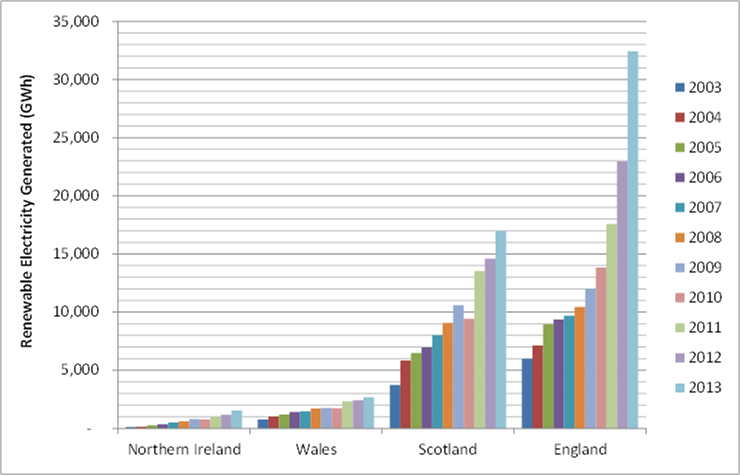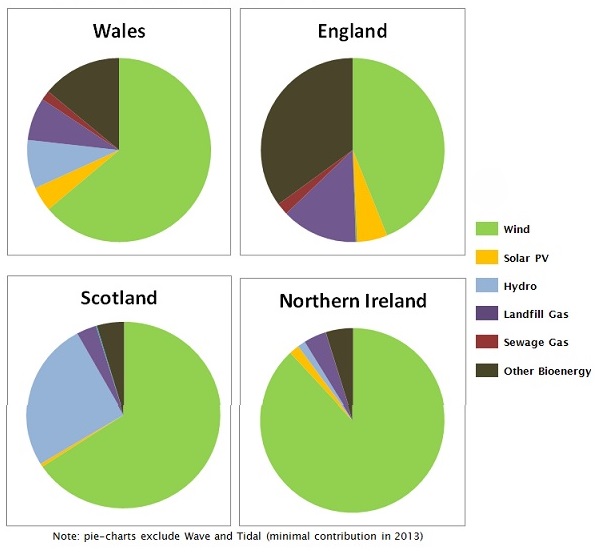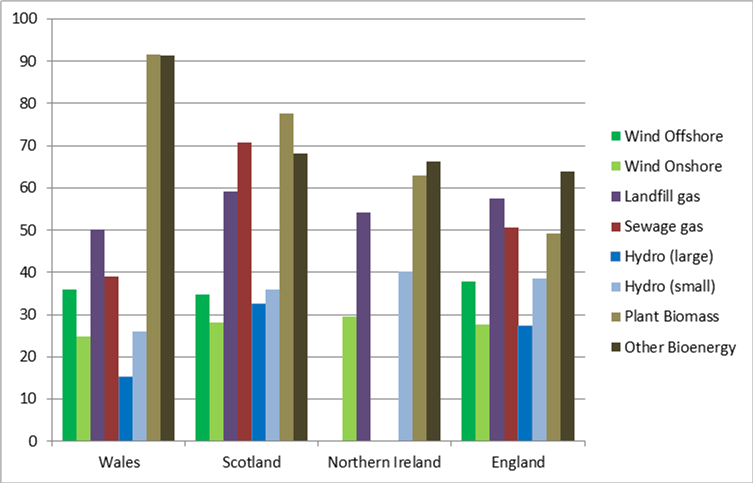Article by Graham Winter and Nigel Barwise, National Assembly for Wales Research Service
This blog post looks at the latest statistics for renewable electricity that have been published by the Department of Energy and Climate Change (DECC) covering the period 2003 to 2013.
The statistics outline the amount of electricity generated by renewable sources as well as the total number of renewable electricity installations, and the load factor (a measure of the proportion of electricity produced compared to the installed capacity). They are shown for the four UK countries and English regions, allowing comparisons to be made on the progress of each country in increasing renewable electricity production.
Electricity generated from renewable resources increased by 9% between 2012-2013 in Wales. The increases in Scotland, Northern Ireland and England were 16%, 30% and 41% respectively.
Electricity Generated from Renewable Sources 2003-2013  The total number of installations (excluding solar) increased by 16% in Wales (from 504 to 586) between 2012 and 2013. Since 2003 the total number of installations (excluding solar) has increased by about 480% in Wales, but this is below the rate of increase in other parts of the UK; Scotland (940%), England (600%) and Northern Ireland (500%).
The total number of installations (excluding solar) increased by 16% in Wales (from 504 to 586) between 2012 and 2013. Since 2003 the total number of installations (excluding solar) has increased by about 480% in Wales, but this is below the rate of increase in other parts of the UK; Scotland (940%), England (600%) and Northern Ireland (500%).
Solar installations in Wales increased by nearly 5,000 (18%) between 2012 and 2013. They account for 98% of installations within Wales but only 4% of the generated energy. This reflects the nature of solar installations, typically being domestic with a low generation capacity.
The proportion of the electricity produced by each type of renewable energy in each country shows some large differences. The high proportion of energy generated by wind in Wales, Scotland and Northern Ireland and by hydro in Scotland reflects the large natural resources these countries have from high wind speeds and sources suitable for hydro. The large proportion of electricity generated by "other bioenergy" in England comes predominantly from two regions, and includes the Drax power station, a coal power station partly converted to burn biomass.
Renewable Electricity Generation by Source for 2013

Wind was the largest source of renewable electricity generation for all four countries in 2013. In Wales electricity generated by wind accounts for about 64% of all renewable electricity generation. The next biggest contributor is ‘other bioenergy’ (about 14%). Wind also saw the largest increase in renewable energy generation in all four countries between 2012 and 2013.
The load factors (the proportion of electricity produced compared to the installed capacity) show some variation between the different technologies, and are shown below for the UK countries and technologies. Solar PV was not reported.
The load factor is a measure of how intensively an energy source is used to generate electricity, and for renewable sources will reflect a number of factors including the ‘reliability’ of the ‘fuel’ (eg: variable amounts of wind or rainfall), the ‘reliability’ of the equipment (breakdowns, maintenance periods etc.), as well as the demand for the energy source and the price of the electricity generated.
Load factors were highest in 2013 for bioenergy and biomass, followed by landfill and sewage gas. Offshore wind load factors were higher than onshore wind. Load factors for onshore wind were slightly lower in Wales than in other parts of the UK in 2013. Hydro (both large and small scale) also had lower load factors in Wales than elsewhere. In contrast, Plant Biomass and ‘Other Bioenergy’ had higher load factors in Wales than elsewhere.
Load Factors for UK Countries and Renewable Electricity Generation Technology - 2013

Note: Based on electricity generated from schemes operating throughout the year with the same installed capacity.






